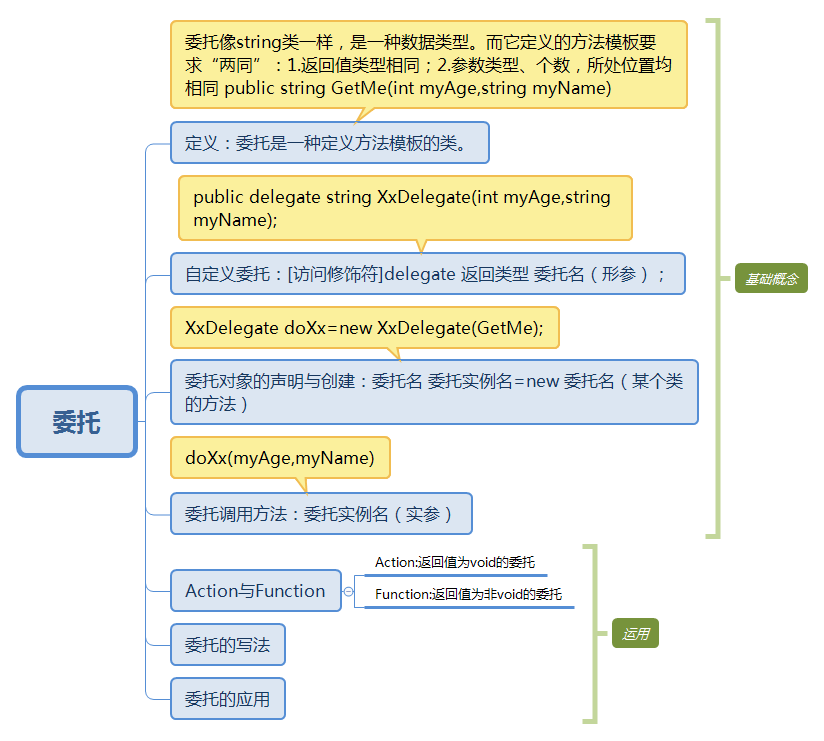通过以下思维导图,学习委托的基本概念,后面着重讲解委托的运用,希望通过最简单的方式收获更多的知识。

1.委托的各种写法
1、委托 委托名=new 委托(会调用的方法名); 委托名(参数);
2、委托 委托名 =会调用的方法名; 委托名(参数);
3、匿名方法:委托 委托名=delegate(参数){会调用的方法体};委托名(参数);
4、拉姆达表达式:委托 委托名=((参数1,。。参数n)=>{会调用的方法体});委托名(参数);
5、用Action<T>和Func<T>
Action<参数1, 参数2,> 委托名= ((参数1,参数2) => {不带返回值的方法体 });委托名(参数1,参数2);
Func<参数1, 参数2, 返回值> 委托名= ((参数1,参数2) => {带返回值的方法体 });返回值=委托名(参数1,参数2);
示例:
public delegate int Call(int num1, int num2); class SimpleMath { // 乘法方法 public static int Multiply(int num1, int num2) { return num1 * num2; } // 除法方法 public int Divide(int num1, int num2) { return num1 / num2; } } class Test { static void Main(string[] args) { //--------------------第一种写法------------------------// Call objCall = new Call(SimpleMath.Multiply); Call objCall1 = new Call(new SimpleMath().Divide); //--------------------第二种写法------------------------// Call objCall = SimpleMath.Multiply; Call objCall1 = new SimpleMath().Divide; //--------------------第三种写法------------------------// Call objCall = delegate(int a, int b) { return a * b; }; Call objCall1 = delegate(int a, int b) { return a / b; }; //--------------------第四种写法------------------------// Call objCall =((int a,int b)=> { return a*b;}); Call objCall1 = ((int a, int b) => { return a / b; }); //--------------------第五种写法------------------------// Func<int, int, int> objCall = ((a, b) => { return a * b; }); Func<int, int, int> objCall1 = ((a, b) => { return a / b; }); Action<int, int> ob = ((a, b) => { Console.WriteLine(a * b); }); ob(5, 3); //----------------------------------------------------// int result = objCall(5, 3); int result1 = objCall1(5, 3); System.Console.WriteLine("结果1为 {0},结果2为{1}", result,result1); Console.ReadKey(); } }
2.委托的运用
委托的运用记住两点:
1.将方法当作参数实例化委托对象;
2.将方法的参数传递给委托对象,以实现实际的方法调用。
委托常用场景:
1.模板方法:
如以下定义类CalculateFactory,用于定义各种计算方法,然后通过Calculate方法暴露出来给外界使用,而Calculate方法通过传入委托对象new Calculate(x1.Add)来实现对Add方法的调用。这是委托模板方法使用较简单的一种形式,它还可以有很多变种。
下面这段程序不用委托完全可以实现同样的逻辑,为什么要“故弄玄虚”呢?因为示例是为了说明委托作为模板方法的用法,故而用了最简单的一种,实际运用过程中,通常与设计模式相结合,以实现代码的高复用低耦合。进一步延伸,实际设计模式中也较少用委托,而用接口、抽象类来实现“模板方法”的功能,具体要怎么用是看个人习惯和便捷程度。委托用的最多的场景是下面要介绍的回调方法。
class Program { static void Main(string[] args) { CalculateFactory x1 = new CalculateFactory(); CalculateFactory x2 = new CalculateFactory(); x1.Calculate(10, 9, new Calculate(x1.Add)); x2.Calculate(10, 9, new Calculate(x2.Reduce)); Console.ReadKey(); } } public delegate void Calculate(int a, int b); public class CalculateFactory { public void Calculate(int a, int b, Calculate calculateDelegae) { calculateDelegae(a, b); } public void Add(int a, int b) { Console.WriteLine(string.Format("This is a+b={0}", a + b)); } public void Reduce(int a, int b) { Console.WriteLine(string.Format("This is a-b={0}", a - b)); } }
2.回调方法:
回调方法与模板方法并不是并列的两种类型,其本质都是一样的,即将方法当成参数传递并调用,是通过应用场景来分类的。主调方法(调用回调方法的方法体)在满足某种条件或完成某种逻辑后去调用的方法,称为回调方法。将上面示例改造成含有回调方法的程序。
示例:这里既用到了模板方法,也用到了回调方法。示例代码来源于刘铁猛大师的示例,在此表示感谢。
class Program { static void Main(string[] args) { ProductFactory productFactory = new ProductFactory(); WrapFactory wrapFactory = new WrapFactory(); Func<Product> func1 = new Func<Product>(productFactory.MakePizza); Func<Product> func2 = new Func<Product>(productFactory.MakeToyCar); Logger logger = new Logger(); Action<Product> log = new Action<Product>(logger.Log); //Log的委托; Box box1 = wrapFactory.WrapProduct(func1, log); Box box2 = wrapFactory.WrapProduct(func2, log); Console.WriteLine(box1.Product.Name); } class Product //产品类 { public string Name { get; set; } public double Price { get; set; } } class Box //盒子类 { public Product Product { get; set; } } class Logger { public void Log(Product product) { Console.WriteLine(product.Price); } } class WrapFactory //包装工厂 { public Box WrapProduct(Func<Product> getProduct, Action<Product> logCallback) { Box box = new Box(); Product product = getProduct.Invoke();//此处使用的是间接的同步调用,如果使用间接异步调用用BeginInvoke(); if (product.Price > 50) //如果产品价格大于50,就执行回调方法; { logCallback(product); } box.Product = product; return box; } } class ProductFactory //产品工厂 { public Product MakePizza() { Product product = new Product(); product.Name = "Pizza"; product.Price = 30; return product; } public Product MakeToyCar() { Product product = new Product(); product.Name = "ToyCar"; product.Price = 100; return product; } } }
3.总结
委托基础内容基本就是这些,回调方法在实际使用中也是最多的,上面回调方法的示例是有实用价值的,需要好好体会。委托还有多播委托等进阶应用,在此不作介绍,但需要了解其概念,以便碰到相应场景时翻翻资料能找到解决方案。



